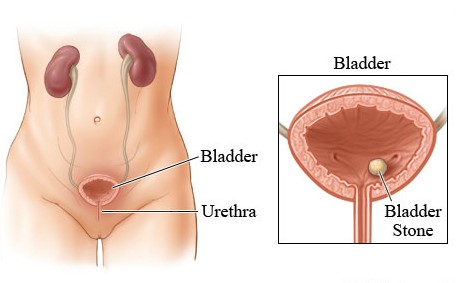

Dr. Dilip Raja
Urologist & Andrologist
Bladder Stones
Bladder Calculi, Vesical Calculus
In India, approximately 5 -7 million patients suffer from stone disease
Get in touch with us today (022) 2645 2007
The Urinary Bladder Stone can either travel from kidney and ureter into the ladder or can be formed in urinary bladder secondary to obstruction in passage.

Causes of Bladder Stone
These bladder stones are usually associated with stasis of urine, but they can form in healthy individuals without evidence of anatomic defects, strictures, infections, or foreign bodies. The presence of upper urinary tract calculi is not necessarily a predisposition to the formation of bladder stones.
- Bladder outlet obstruction remains the most common cause of bladder calculi in adults.
- Prostatic enlargement.
- Elevation of bladder neck.
- High postvoid residual urine volume cause stasis, which leads to crystal nucleation and accretion
Symptoms of Bladder Stone
The presentation of vesical calculi (urinary bladder calculi) varies from completely asymptomatic to the following symptoms
- Suprapubic pain (lower abdominal)
- Dysuria (pain while passing urine)
- Intermittent flow of urine
- Increased frequency of urination
- Hesitancy
- Nocturia
- Urinary retention
Investigations
- X-ray KUB will show the presence of the stone in the pelvis
- Sonography will show the presence of the stone with clue to formation of bladder stone like enlarged prostate.
Treatment of Bladder Stones
Transurethral Litholapaxy
Cystoscopy is performed to evaluate lower urinary tract like urethra and prostate and finally to visualize the stone into the bladder. If the stone is small., it can be manually fragmented with the forceps and the fragments are removed through the cystoscope.
Percutaneous Suprapubic Cystolithotomy
In case of larger bladder stone, the percutaneous suprapubic route is selected. This allows the use of shorter- and larger-diameter endoscopic equipment like nephroscope (usually with an ultrasonic lithotripter), which allows rapid fragmentation and evacuation of the calculi. Often, a combined transurethral and percutaneous approach can be used to aid in stone stabilization and to facilitate irrigation of the stone debris.
Open Suprapubic Cystolithotomy
This procedure become the preferred mode of treatment for very large or multiple bladder calculi associated with enlargement of prostate.
